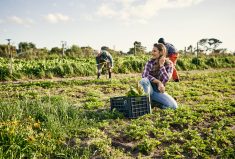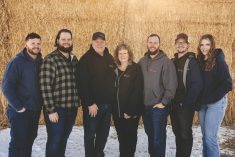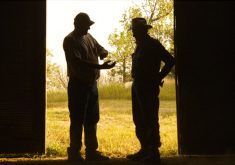We know that grief is a natural response when a loved one dies. What we may not realize, though, is that we may also grieve, sometimes for years, from non-death losses too.
Losing the family farm, getting divorced, living with a debilitating illness, being estranged from one’s child, the turmoil of the COVID-19 pandemic… all of these situations can provoke feelings of loss and grief, says Dr. Darcy Harris, a grief counsellor and professor at Western University in London, Ont.
“With the COVID-19 pandemic, there is the grief of losing life as we know it,” explains Harris. “People are navigating a new world that has been thrust upon them.”
Read Also

Ground rules for farm family communications
Establishing meeting ground rules can help your family find ways to communicate that work for your farm. Here are some…
But is it important to be able to label that what we’re feeling is actually grief? Harris and two other grief experts consulted for this story say that it is.
Grief is a natural process that helps us adapt when the world as we knew it — or thought we knew it — no longer exists, says Harris. “Grief is a process to help us integrate the thing that has happened, to think, ‘This is my life now. It’s not the life I planned… that life is gone.’ It helps you reconcile the disparity.”
“It also helps to have the words to describe the experience, to be able to talk about it and to share it,” continues Harris.
“In order to mourn a loss, we have to start by recognizing that loss,” agrees Litsa Williams, a clinical social worker and founder of the Baltimore, Maryland grief resource website What’s Your Grief?
Labelling grief gives us permission and gives us the space we need to look for support, says Williams. “People need validation, normalization and social support.”
It’s also important to be able to differentiate feelings of grief from the symptoms of depression to ensure the proper diagnosis and treatment, continues Harris. In most cases, grief doesn’t require professional intervention.
“Grief is not a problem to be solved. It is not something to get over. We are not broken,” says Williams.
When we picture someone who is grieving, we may visualize a person who is sad, but grief can involve physical, emotional, spiritual and cognitive symptoms, says Harris. “It can take different paths, not just emotional, such as loss of concentration, headaches, backaches, fatigue.”
The nature of some losses can make them more difficult to identify and, hence, to get the support we need, warns Melina Pearson, outreach co-ordinator at Bereaved Families of Ontario in Kitchener, Ont. Some of these “ambiguous losses” include having a loved one who is living with dementia, who is incarcerated, who has had a traumatic brain injury, who has joined a religious cult, who has a drug addiction, or who is suffering from mental illness.
With ambiguous losses, “The person you love is still there… but say things they would never have said, treat you in ways they never would have treated you, and they are not there for you in ways they previously were,” explains Williams.
Being unable to see a loved one due to the COVID-19 pandemic is another example of an ambiguous loss, says Harris, adding, “with ambiguous losses there is the absence/presence dynamic.”
In addition to the primary loss, we may also experience secondary losses such as the loss of identity, loss of income, loss of faith and loss of dreams, says Pearson. A mother who loses her only child may question if she is still a mother. The death of a partner may result in a loss of financial security. A lack of support from friends and family may lead to damaged relationships. These are all examples of secondary losses that stem from the original loss.
By identifying these secondary losses, we are better equipped to mourn them, says Williams. “We begin to understand that the whole of our grief is comprised of many parts.”
But it still leaves us with a question. Okay, so we’ve identified that what we’re feeling is grief, but now what?
Unfortunately, there are no hard and fast rules for grieving. We are all individuals and we all grieve differently, says Harris. “How we will mourn and adapt will vary depending on who we are and what the loss is,” agrees Williams.
“There is no one-size-fits-all solution. We need to find healthy ways to cope,” says Pearson. For some meditation, yoga, prayer, music or telling stories may be helpful coping methods, she says, adding “focus on your basic needs like sleep and breathing.”
Don’t be afraid to ask for help and to accept it, continues Pearson. “That’s not being selfish,” she says. “Recognize what you need and reach out. It doesn’t make you weak.”
Also practice self-care, whatever that looks like for you, adds Pearson.
Helpful options cover a wide range, from writing in a journal or creating art to doing grounding exercises for anxiety and stress, adds Harris.
Talking with friends, family, peer supports and counsellors can help us define the loss and create a meaningful narrative, says Pearson.
“Trying to find a way to make meaning of your life and to find a way to step forward into life” can be helpful for those who are grieving, says Harris. Some people experience personal growth, appreciate life more, become more sensitive to others who are suffering, says Harris.
All three experts emphasize the importance of social support for the grieving person. The grief resulting from losses that are not recognized by society (academics call this disenfranchised grief) can be especially lonely when the griever feels like they must hide their painful feelings because their loss isn’t recognized by society, says Williams. “They may feel like their grief makes other people uncomfortable.”
“There is a lot of social pressure to grieve a certain way,” agrees Harris, who warns to avoid gender stereotypes. “Don’t make assumptions about how someone should grieve. It’s about what’s right for them.”
When it comes to supporting a loved one who is grieving, we should empathize with them, says Harris. “Don’t engage in the grieving Olympics,” she warns. “Don’t judge, don’t minimize the loss, don’t compare experiences. Grief is a response to loss, however that person describes that loss. Grief is very individual, very subjective.”
“Just be there,” says Pearson. “Listen. Don’t talk over them. Do not assume you know how they feel. Follow their lead.”
And don’t tell people it’s time to get over it. There is no timeline, no end point when we experience a major loss, emphasizes Williams. “It’s a weight that doesn’t go away. We need to learn to integrate the loss, to learn how to carry it. We learn tools and find support.”
Resources
- The Canadian Virtual Hospice, a registered charity, has a comprehensive and interactive website providing support and personalized information about palliative and end-of-life care and grief to patients, family members, health care providers, researchers and educators.
- The What’s your grief? website aims to promote grief education, exploration and expression in both practical and creative ways. Includes podcasts on many grief-related topics.
















